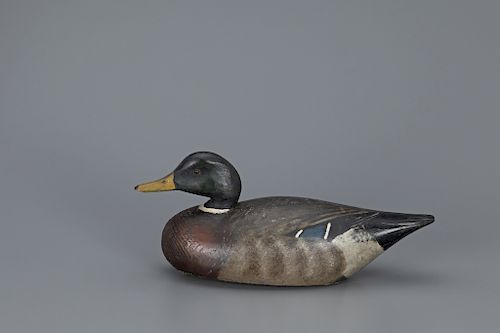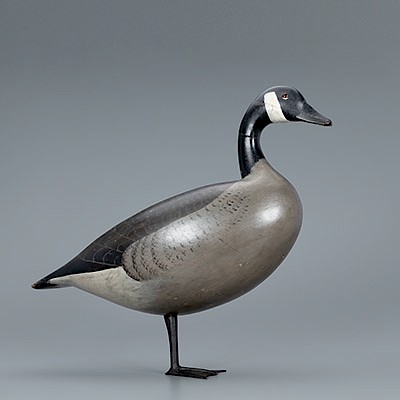"Boss" Hoover Mallard Drake, A. Elmer Crowell (1862-1952)
Lot 181
About Seller
Copley Fine Art Auctions
20 Winter Street
Pembroke, MA 02359
United States
Founded in 2005, Copley Fine Art Auctions is a boutique auction house specializing in antique decoys and American, sporting, and wildlife paintings. Over the course of the last two decades, the firm has set auction records for not only individual decoy makers, but also entire carving regions. Copley...Read more
Estimate:
$20,000 - $25,000
Absentee vs Live bid
Two ways to bid:
- Leave a max absentee bid and the platform will bid on your behalf up to your maximum bid during the live auction.
- Bid live during the auction and your bids will be submitted real-time to the auctioneer.
Bid Increments
| Price | Bid Increment |
|---|---|
| $0 | $50 |
| $1,000 | $100 |
| $2,500 | $250 |
| $5,000 | $500 |
| $10,000 | $1,000 |
| $25,000 | $2,500 |
| $50,000 | $5,000 |
About Auction
By Copley Fine Art Auctions
Feb 16, 2019
Set Reminder
2019-02-16 10:00:00
2019-02-16 10:00:00
America/New_York
Bidsquare
Bidsquare : The Winter Sale 2019
https://www.bidsquare.com/auctions/copley/the-winter-sale-2019-3820
The sale will offer the opportunity to view and take home world-class paintings and fine bird carvings. Featuring selections from the collections of Alfred Ely, L. H. LaMonte, Grant Nelson, Ronald S. Swanson, Herb Wetanson, and a descendant of Chester F. Spear among others. Copley Fine Art Auctions cinnie@copleyart.com
The sale will offer the opportunity to view and take home world-class paintings and fine bird carvings. Featuring selections from the collections of Alfred Ely, L. H. LaMonte, Grant Nelson, Ronald S. Swanson, Herb Wetanson, and a descendant of Chester F. Spear among others. Copley Fine Art Auctions cinnie@copleyart.com
- Lot Description
"Boss" Hoover Mallard Drake
A. Elmer Crowell (1862-1952)
East Harwich, MA, c. 1925
17 3/4 in. long
This bold drake with full cheek carving and a pronounced breast is one of Crowell’s best examples of this rare species. When this decoy was made, mallards were not as prevalent along the Atlantic Flyway, as is evidenced by their scarce representation as decoys along the East Coast. Indeed, this large mallard was ordered in 1925 for use at the Toussaint Shooting Club in Port Clinton, Ohio. One of the most important decoys to come out of Ohio, Crowell’s patron for this rare species was William H. “Boss” Hoover (1849-1932), founder of the vacuum cleaner company. The underside bears Crowell’s oval brand and a painted “HOOVER” owners designation.
Regarding the industrial giant, Ohio History Central states, “As a young man, he became involved in the leather business, working as a tanner. He remained involved in the tannery business until the first decade of the twentieth century. In 1908, Hoover purchased John Murray Spangler’s patent for the upright vacuum cleaner. Ultimately, Spangler’s invention became known as the Hoover vacuum cleaner... the largest vacuum cleaner manufacturer in the world.”
A world traveler and sportsman, between 1910 and 1920 Hoover opened up factories in Canada and England. A monumental American figure, even today the act of vacuuming in England is often referred to as “hoovering.” Original paint with even gunning wear, minor touch-up around eyes and to a chip at left edge of bill.
Provenance: William H. "Boss" Hoover Rig
Rusty and Dianna Johnson Collection, acquired from Decoys Unlimited
Literature: Ohio History Central, "William H. Hoover," www.ohiohistorycentral.org/w/William_H._Hoover, November 27, 2018.
Stephen B. O'Brien, Jr. and Chelsie W. Olney, "Elmer Crowell: Father of American Bird Carving," Hingham, MA, 2019.Condition report requests can be made via email or by telephone (info@copleyart.com or 617.536.0030). Any condition statement given is a courtesy to customers, Copley will not be held responsible for any errors or omissions. The absence of a condition statement does not imply that the lot is in perfect condition.Condition
- Shipping Info
-
Shipping info
Copley Fine Art Auctions does not handle the shipping of any items. Shipping is the sole responsibility of the buyer. Once your payment has cleared, and we have received your authorized shipping release form items may be released for shipment. Copley Fine Art Auctions, LLC shall have no liability for any loss or damage to such items. Buyers should allow up to four weeks for shipment.Please be aware that internet bidders may NOT not pick up their items at the sale. Items will be available for pick up by appointment or by shippers five days after the sale.
-



 EUR
EUR CAD
CAD AUD
AUD GBP
GBP MXN
MXN HKD
HKD CNY
CNY MYR
MYR SEK
SEK SGD
SGD CHF
CHF THB
THB
















